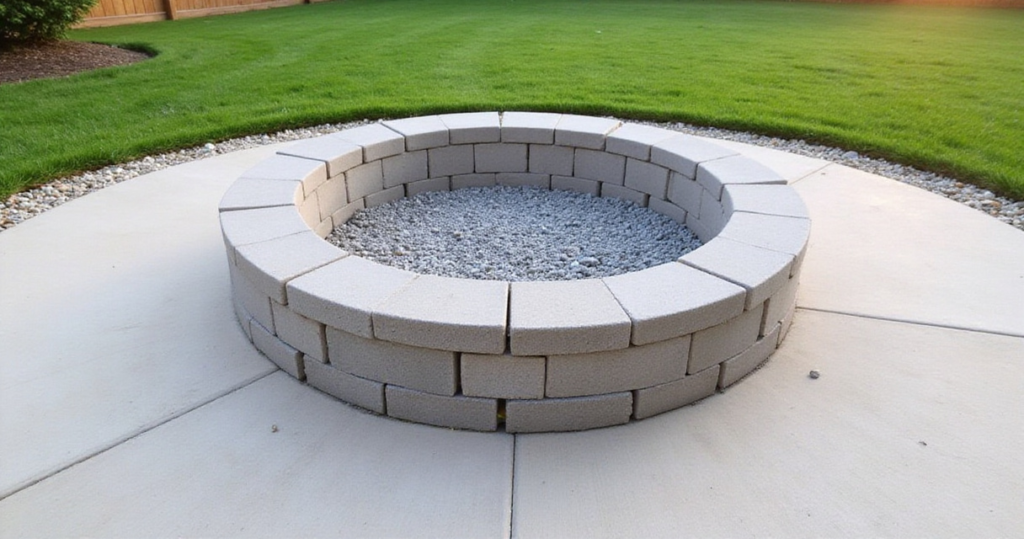The British have always understood that a garden isn’t merely an outdoor space—it’s an extension of one’s home and personality. Yet contrary to the grand estates of historical fame, creating a captivating backyard needn’t require a royal treasury. As someone who’s spent a decade working with London’s leading design houses, I’ve discovered that the most charming gardens often emerge from creativity rather than lavish spending.
With these 20 backyard ideas on a budget, you’ll discover how to transform your outdoor haven with a distinctly British sensibility—mixing practicality with whimsy, heritage with modernity. Whether you have a postage stamp-sized city garden or a more generous country plot, these affordable solutions will help you create a space that feels both timeless and thoroughly personal. Grab your gardening gloves and let’s reimagine what’s possible when ingenuity meets inspiration!
1. Build a Simple DIY Fire Pit
The fire pit has become the modern equivalent of the traditional British hearth—a gathering point that extends the outdoor season well into those crisp autumn evenings. Creating your own couldn’t be simpler: arrange concrete landscaping blocks in a circle, add a gravel base, and you’ve crafted an instant focal point for under £200. The beauty lies in its adaptability; choose rustic stone for a cottage garden feel or sleek concrete for contemporary spaces.
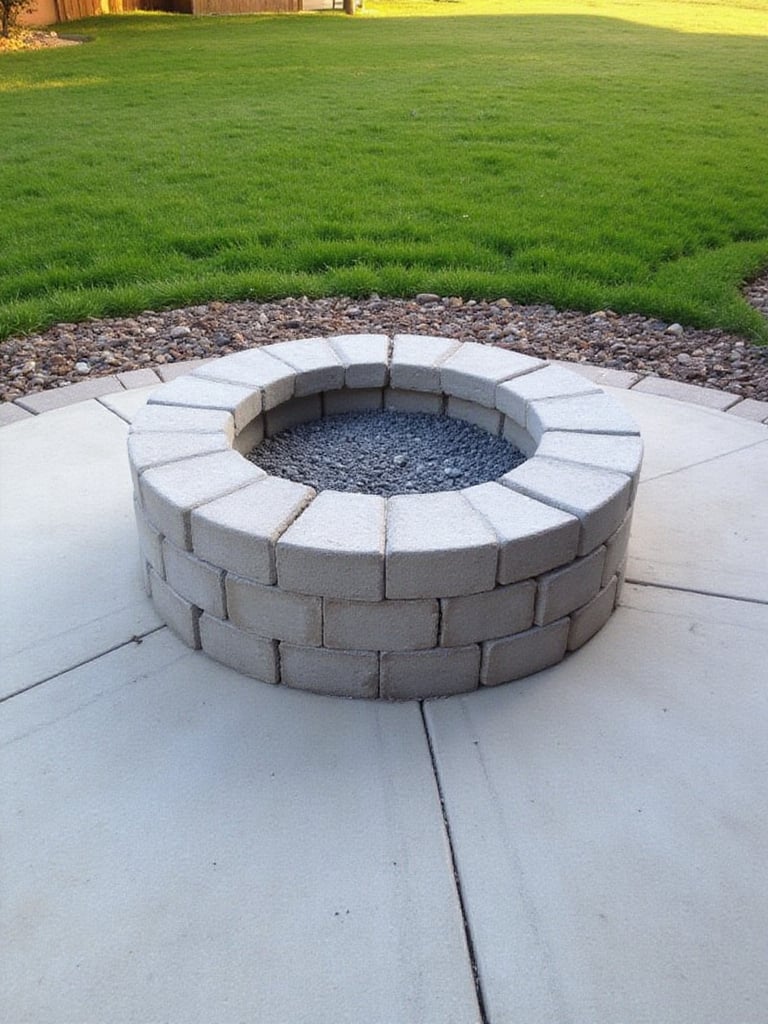
Remember to position your pit at least 3 metres from structures and overhanging trees. The base should be non-combustible—a 10cm layer of crushed stone works brilliantly—and consider local regulations before your first marshmallow roast.
The magic of this piece lies in the way it transforms your garden after dusk, creating a warm, flickering glow that draws people together in conversation. As you plan the surrounding seating area, consider how lighting might further enhance this evening ambiance.
2. String Up Twinkling Fairy Lights
Nothing captures the enchantment of a British garden party quite like the gentle glow of string lights dancing overhead. These twinkling beauties create instant atmosphere without the expense of permanent lighting installations. Opt for solar-powered LED versions—they’ll save you both installation hassle and ongoing electricity costs while illuminating your space with a soft, inviting radiance.
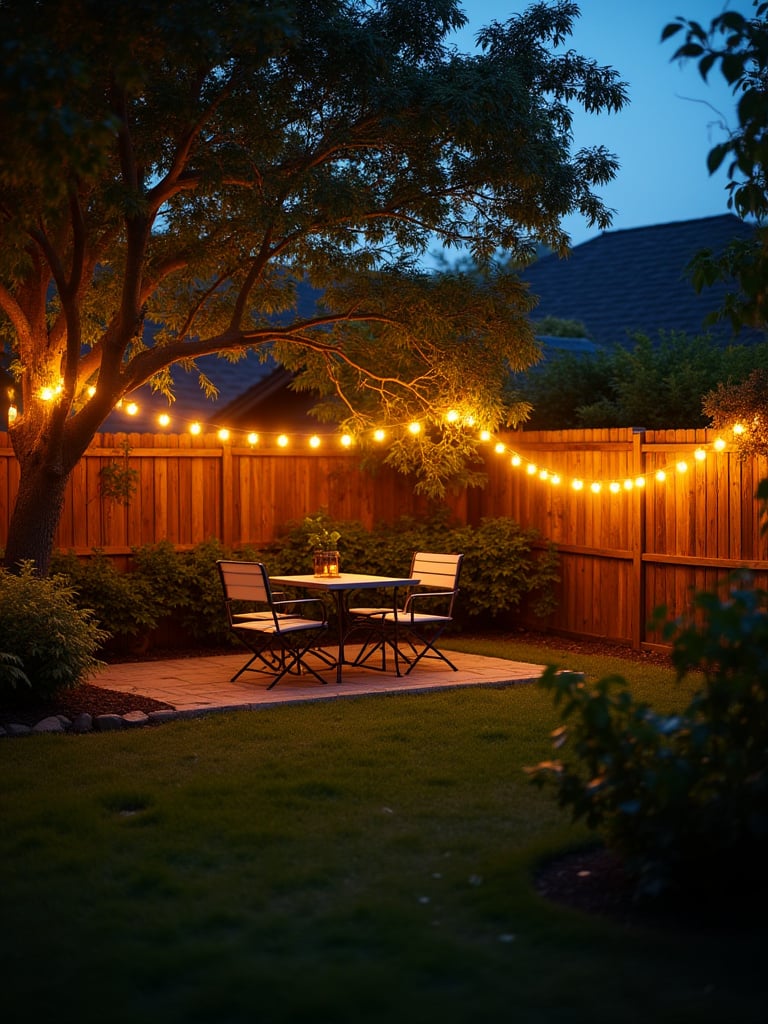
For a quintessentially British look, weave lights through tree branches or suspend them in gentle scallops along fencing. The effect mimics stars peeking through a canopy, creating the perfect backdrop for evening gatherings. Warm white bulbs tend to create a more sophisticated atmosphere than coloured options, particularly when reflected in glassware on a simply laid table.
While traditional methods used costly electrical wiring, the unexpected environmental benefit comes from today’s solar technology—allowing even the most remote garden corner to shimmer without complex installation or running costs. This sustainable approach pairs beautifully with our next backyard idea on a budget: repurposing pallets into garden furniture.
3. Create Furniture from Pallets
The British have always appreciated good craftsmanship with a practical edge, and pallet furniture embodies this perfectly—offering rustic charm at remarkably little expense. Look for pallets marked ‘HT’ (heat-treated) rather than chemically treated versions, then transform them into everything from simple benches to L-shaped sectional seating. A standard pallet, some exterior screws, and a tin of weather-resistant paint are all you need to begin.
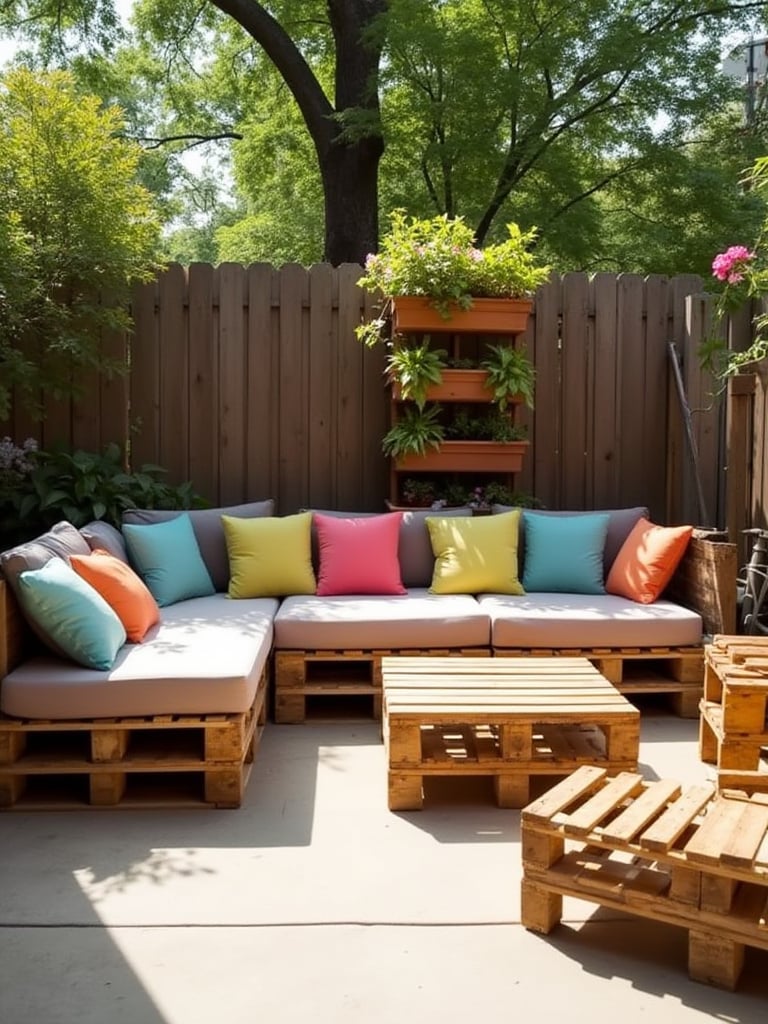
Consider these popular pallet projects:
- Low modular seating with cushions
- Rustic coffee tables
- Vertical herb gardens
- Simple deck loungers
- Compact dining sets
For a distinctly British twist, paint your pallet furniture in heritage colours—think Farrow & Ball-inspired shades like sage green, dusty blue, or warm terracotta. Top with cushions in classic patterns such as ticking stripes or subtle florals for that perfect blend of comfort and style.
The craftsmanship reveals itself in details like sanded edges and properly sealed surfaces, transforming humble shipping materials into pieces that could easily feature in a country garden or urban terrace alike. Speaking of vertical spaces, let’s explore how your fence can become more than just a boundary.
4. Start a Vertical Garden on a Fence
The vertical garden is a brilliant solution for British gardens where space often comes at a premium. By turning an ordinary fence into a living tapestry of plants, you’re essentially doubling your growing area without sacrificing precious ground space. This approach has roots in the Victorian era, when innovative gardeners began training plants upward to maximize limited urban plots.

For a budget-friendly vertical garden, consider these options:
- Repurposed wooden guttering attached horizontally
- Fabric shoe organisers hung from fence posts
- Recycled plastic bottles cut and mounted as planters
- Old wooden crates affixed to the fence
- Upcycled tin cans painted in complementary colours
The planting choices should reflect your fence’s light conditions—north-facing fences suit ferns, heucheras and hostas, while sunny south-facing boundaries provide perfect conditions for strawberries, herbs and trailing nasturtiums. Ensure every container has proper drainage to prevent waterlogging, which is particularly important in our damp British climate.
Beyond aesthetics, the unexpected environmental benefit comes from the insulating properties of a plant-covered fence, which can moderate temperature fluctuations in your garden. This green barrier naturally connects to our next backyard idea on a budget—finding creative vessels for your favourite plants.
5. Repurpose Old Items as Planters
The British garden tradition has always embraced a certain charming eccentricity—think Victorian collectors displaying exotic specimens in curious containers. Channel this heritage by transforming everyday objects into distinctive planters. Old zinc watering cans, chipped teapots, vintage wooden toolboxes, and even worn Wellington boots can house cheerful displays of seasonal blooms or herbs.
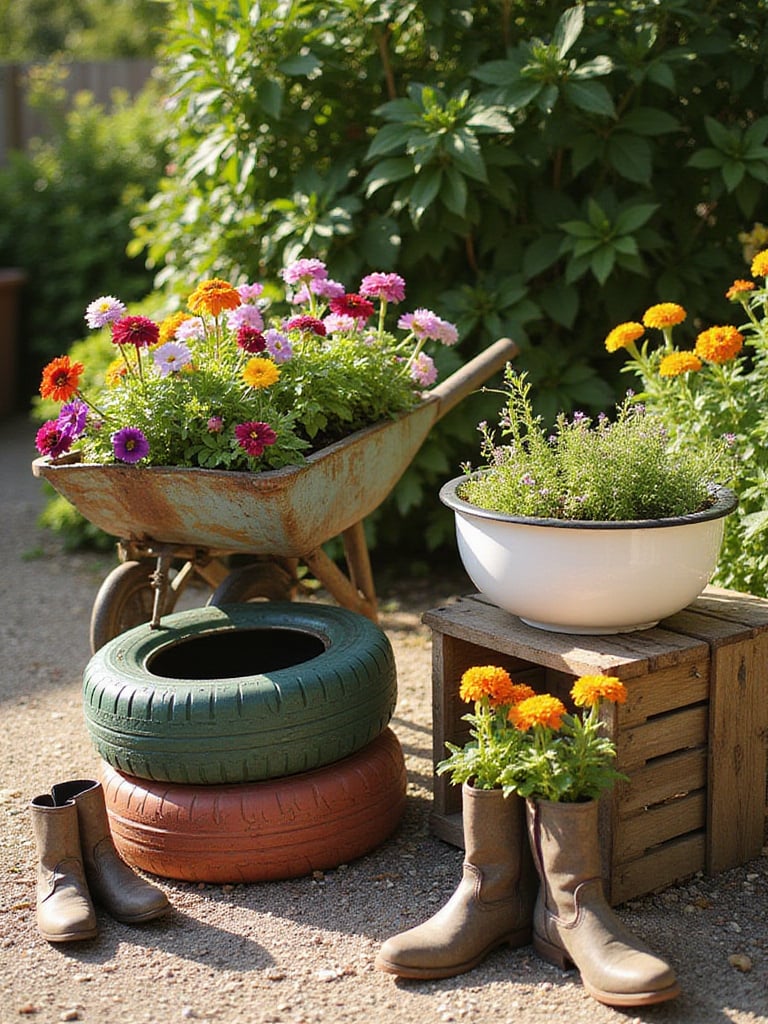
The secret to success lies in proper preparation: ensure adequate drainage by drilling holes in the bottom of containers (use a masonry bit for ceramics), add a layer of gravel before soil, and consider the container’s material when choosing plants. Metal heats up quickly in sunshine, making it better for drought-tolerant plants, while porous terracotta suits Mediterranean herbs that prefer drier conditions.
“The most beautiful gardens tell stories through objects that have lived previous lives. A Victorian coal scuttle filled with trailing lobelia speaks of history and imagination in a way no new plastic pot ever could.” – Garden historian Sarah Rutherford
As morning light filters through your garden, these characterful containers create delightful focal points that draw the eye and invite conversation. Their placement naturally guides visitors through your space, which brings us to creating pathways that enhance your garden’s flow.
6. Lay Down a Budget-Friendly Gravel Path
Gravel paths have featured in British gardens for centuries, from humble cottage gardens to grand estates, offering a practical yet aesthetically pleasing solution that won’t break the bank. The crunching sound underfoot—what garden designers call ‘crepitation’—adds a sensory dimension that solid paving simply cannot match. At roughly £40-60 per tonne, gravel provides excellent value compared to stone slabs or brick pavers.
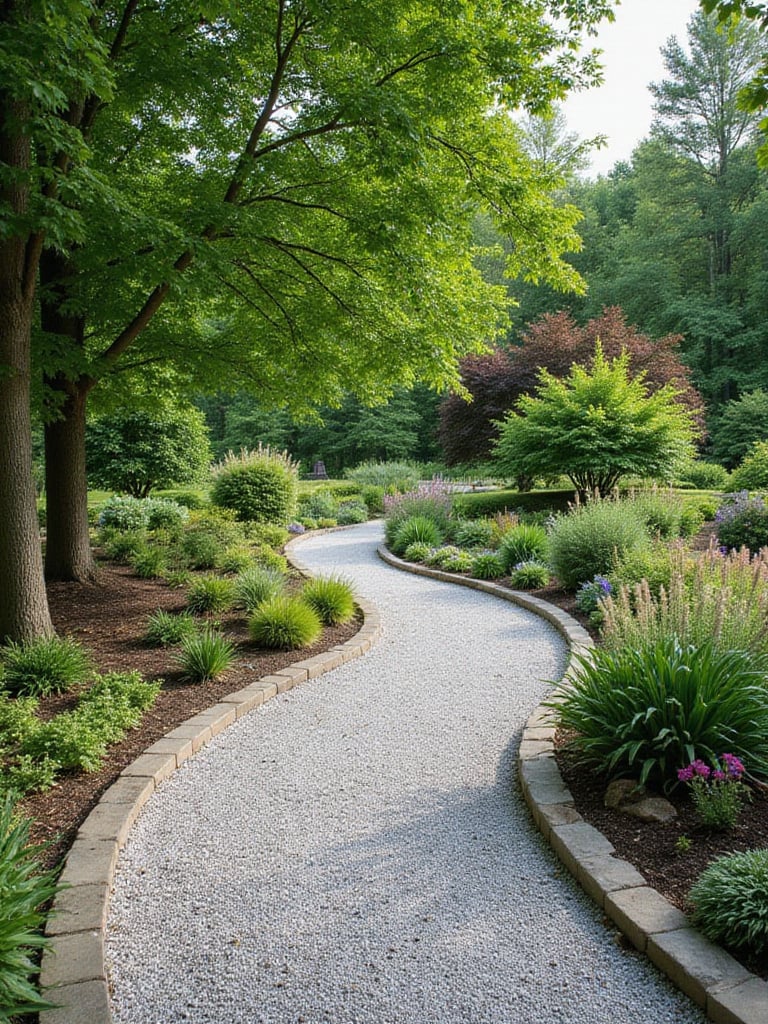
Creating a simple gravel path involves:
- Marking out your desired route using string or garden hose
- Digging down 10-15cm along the path
- Laying landscape fabric to suppress weeds
- Installing edge restraints (recycled plastic, metal or timber)
- Adding and compacting a sub-base of hardcore if needed
- Spreading a 5cm layer of gravel and raking level
For a quintessentially British look, choose a locally-sourced gravel that complements your garden’s colour palette—Cotswold stone for warm honey tones or slate chippings for cool blue-grey hues. Consider mixing in larger stepping stones at regular intervals to create rhythm and reduce the amount of gravel needed.
The designer’s secret here is to create subtle curves rather than straight lines where possible—these feel more natural and guide the eye through the garden in a more pleasing manner. Once your path is established, you’ll want to ensure the surrounding elements look equally appealing, which might require refreshing tired furniture.
7. Give Existing Furniture a Fresh Coat of Paint
The British have long understood the transformative power of paint—just look at our distinctive coloured front doors! This same principle applies brilliantly to garden furniture. A tired wooden bench or faded metal bistro set can be utterly transformed with quality exterior paint in a well-chosen shade. This approach costs a fraction of buying new pieces while allowing you to create a cohesive colour story in your garden.
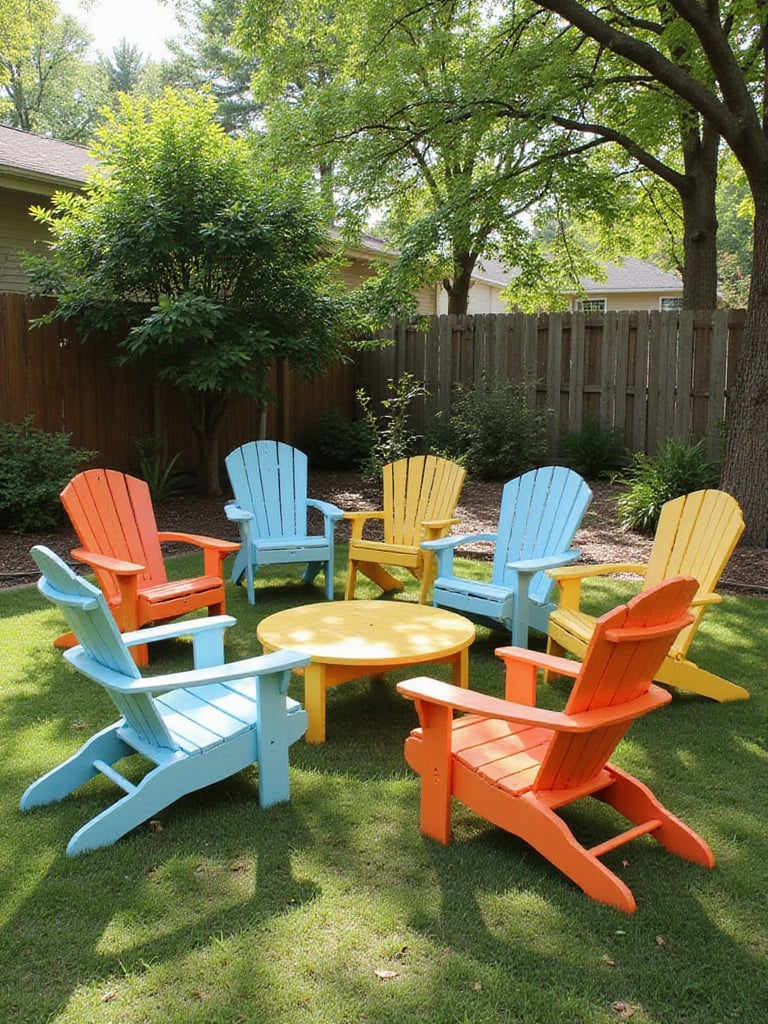
Before painting, preparation is paramount:
- Clean thoroughly with appropriate cleaner (sugar soap works well)
- Sand wooden surfaces to create a key for the paint
- Apply rust treatment to any metal corrosion
- Prime bare wood or metal for better adhesion
- Apply 2-3 thin coats rather than one thick layer
For colour inspiration, look to classic British garden traditions—the soft greens of Victorian conservatories, the vibrant blues of Sissinghurst, or the warm terracottas of Mediterranean-inspired gardens. Don’t be afraid to introduce a pop of unexpected colour; a bench in raspberry pink or daffodil yellow can become a delightful focal point against green foliage.
The craftsmanship reveals itself in details like proper preparation and careful brushwork, transforming ordinary furniture into something that feels bespoke and considered. Once your seating area is refreshed, you’ll want to define it further, perhaps with the addition of a simple textile element.
8. Add an Affordable Outdoor Rug
In British gardens, we’re increasingly borrowing from our interior design sensibilities, blurring the boundaries between indoor and outdoor living. An affordable outdoor rug (typically £30-100) instantly defines a seating area and adds textural interest underfoot. These hardwearing textiles are specifically designed to withstand our changeable weather, resisting mould, mildew and fading from our occasional bursts of sunshine.
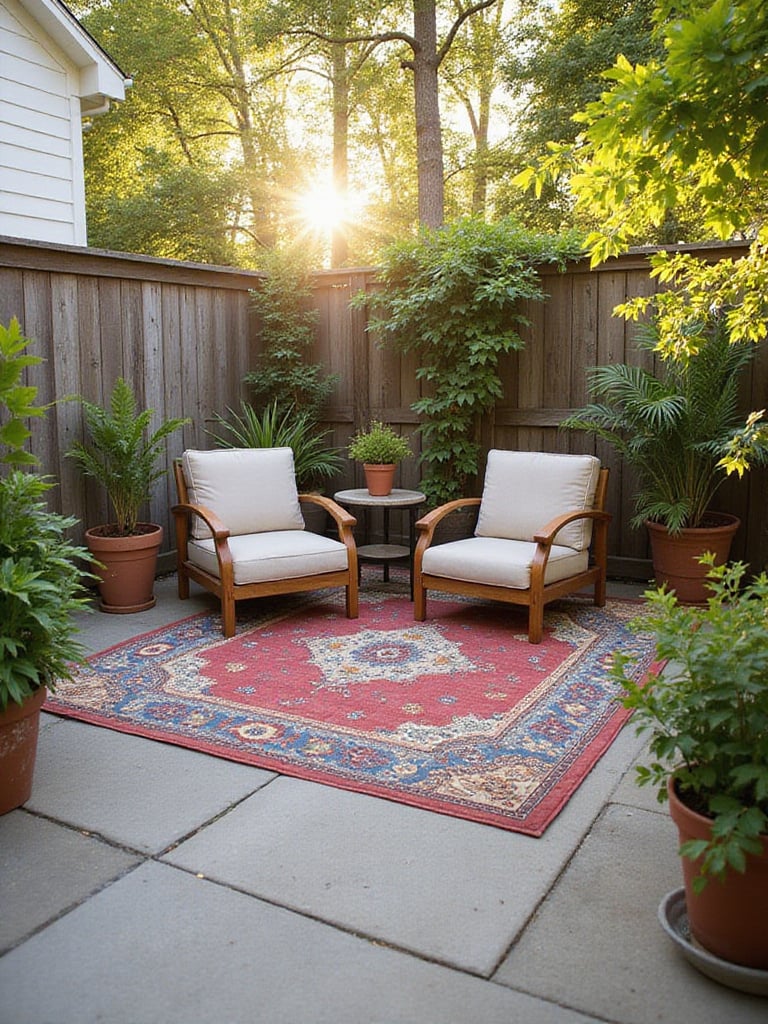
When selecting an outdoor rug, consider:
- Size: Ensure all furniture legs can sit comfortably on the rug
- Material: Polypropylene offers excellent weather resistance
- Pattern: Geometric designs hide dirt better than plain colours
- Colour: Choose tones that complement your existing scheme
- Maintenance: Opt for easily cleanable options
For a quintessentially British look, consider designs that echo traditional patterns—muted stripes reminiscent of deck chairs, subtle geometrics that nod to Victorian tile work, or botanical prints that complement your planting scheme. The rug becomes the foundation of your outdoor room, visually anchoring furniture groups and adding a layer of comfort.
The unexpected environmental benefit comes from rugs made from recycled plastic bottles, which divert waste from landfill while creating a durable garden accessory. This sustainable approach complements our next backyard idea on a budget, which also makes creative use of basic materials.
9. Make Your Own Stepping Stones
There’s something quintessentially British about personalised garden stepping stones—they combine our love of gardening with our appreciation for handcrafted touches. Creating your own costs a fraction of buying ready-made versions, with a basic concrete mix starting at around £5 per bag, enough for several stones. The process is surprisingly simple, requiring only concrete, water, moulds (which can be repurposed baking tins or plastic containers), and decorative elements if desired.

The possibilities for customisation are endless:
- Press leaves or ferns into the surface for a fossil-like impression
- Embed sea glass or broken crockery for a mosaic effect
- Add concrete pigment for subtle colour variations
- Stamp with words or dates to commemorate special occasions
- Create impressions of children’s handprints or footprints
For the most professional results, ensure your concrete is properly mixed to a thick porridge consistency and vibrate the mould gently after pouring to remove air bubbles. Allow at least 48 hours of curing time before removing from moulds, and a further week before placing in the garden.
The artisan collective that creates these pieces extends to include you—there’s a profound satisfaction in walking on stones you’ve crafted yourself. This connection to craftsmanship naturally extends to other garden elements that reflect your personality, including features that attract wildlife.
10. Craft a DIY Bird Feeder or Bath
The British have always maintained a special relationship with garden birds—from the Victorian ornithologists who documented our feathered friends to today’s RSPB Garden Birdwatch. Creating a simple bird feeder or bath costs mere pennies yet brings immeasurable joy as you observe the resulting avian activity. A basic bath might utilise a terracotta pot saucer elevated on stones, while feeders can be fashioned from recycled bottles, tin cans, or even hollowed-out citrus fruits.
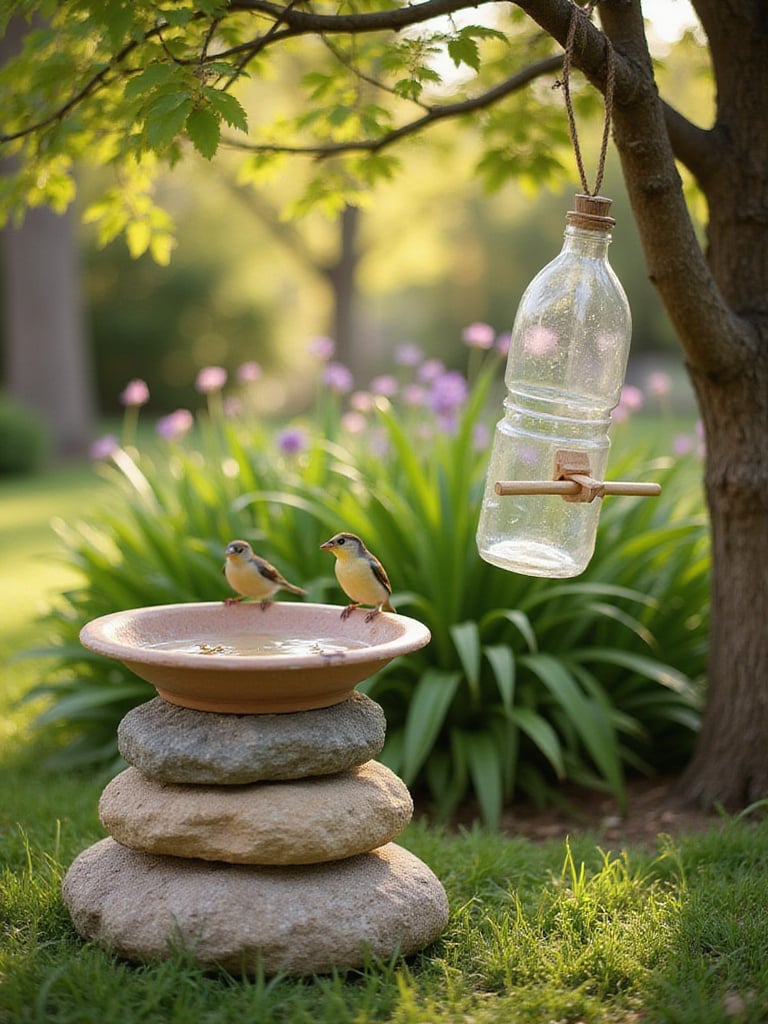
When designing your bird features, consider:
- Placement: Position away from potential predator hiding spots
- Depth: Bird baths should be shallow (2-3cm at edges)
- Stability: Ensure feeders don’t swing excessively in our British breezes
- Cleanliness: Design for easy weekly cleaning
- Access: Include perching spots of varying sizes
For a distinctly British touch, mount your feeder on a reclaimed piece of architectural salvage—perhaps an old iron bracket or wooden finial. This combines functionality with decorative appeal, creating a focal point that serves both wildlife and aesthetic purposes.
The historical influence reimagined for today connects our long-standing British tradition of garden birdwatching with contemporary sustainability practices. As you encourage wildlife, you might also consider growing edibles—another backyard idea on a budget with deep roots in British garden history.
11. Plant a Small Herb or Vegetable Garden
The British kitchen garden tradition dates back centuries, from medieval monastery gardens to Victorian potagers. Today, growing even a modest selection of herbs and vegetables brings multiple benefits: fresh produce at your fingertips, significant savings on grocery bills, and the incomparable satisfaction of eating what you’ve grown. Starting costs are minimal—a packet of seeds typically costs £2-3 and can produce dozens of plants.
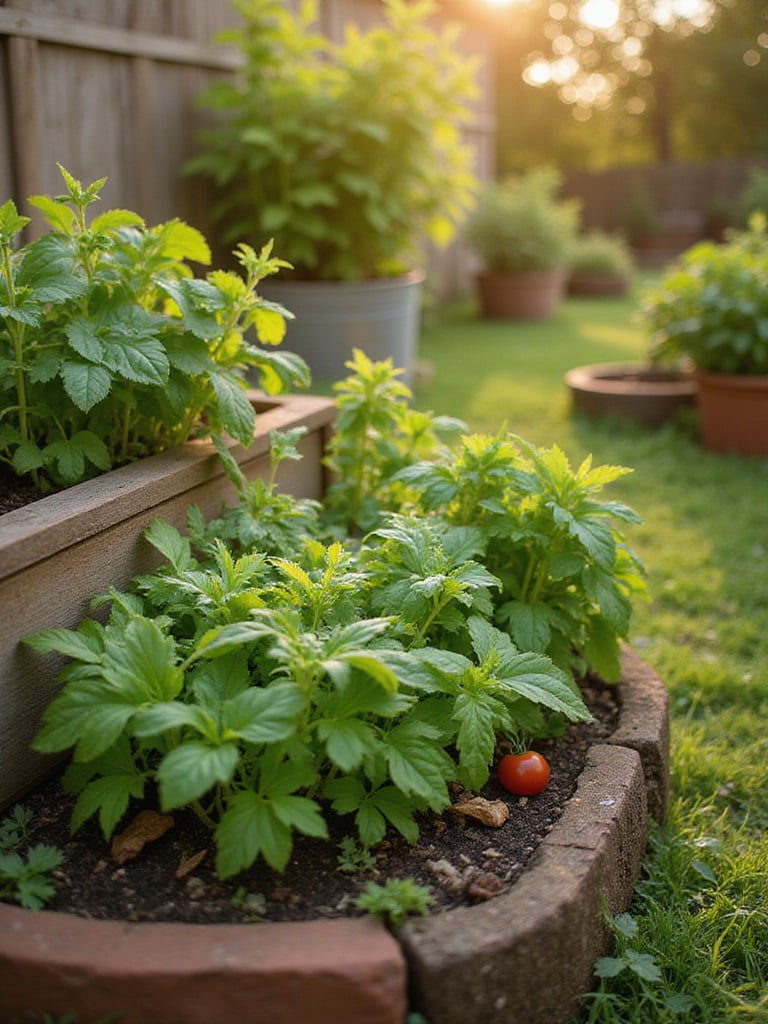
For beginners with limited space, consider:
- Herbs: Mint, rosemary, thyme and chives thrive in pots
- Salad leaves: Cut-and-come-again varieties provide multiple harvests
- Tomatoes: Cherry varieties succeed even in hanging baskets
- Courgettes: One plant can produce for months
- Beans: Runner beans grow vertically, maximising space
The British approach to kitchen gardening embraces practicality with a touch of whimsy—mix edibles with flowers like nasturtiums and calendula (both edible themselves), and don’t feel constrained by conventional garden layouts. A strawberry plant can be as decorative as it is delicious when spilling from a hanging basket.
The environmental story behind this piece began thousands of years ago with our ancestors’ first cultivation efforts, yet continues to evolve as we rediscover the joys of growing food close to home. This connection to the land extends beautifully to our next idea, which brings tactile play opportunities to younger garden visitors.
12. Build a Simple Sandbox for Kids
While formal gardens might be a British tradition, we’ve always understood the importance of creating spaces where children can connect with nature through play. A simple sandbox offers sensory experiences and creative possibilities for little ones, and can be constructed for under £100. The most straightforward design uses pressure-treated timber to create a square frame (typically 1.2m x 1.2m), lined with landscape fabric and filled with play-grade sand.

Consider these child-friendly enhancements:
- A hinged lid that doubles as seating when opened
- Partial shade from a simple canopy or nearby planting
- Natural elements like smooth stones or shells for play
- Small digging tools stored in a weather-resistant container
- Rounded corners and sanded edges for safety
Position your sandbox where you can observe children at play, ideally with some natural shade during the hottest part of the day. In typical British gardens where space is often limited, consider a corner location that maximises the available area while creating a dedicated children’s zone.
The magic of this piece lies in its ability to engage children’s imagination while connecting them to the sensory experience of natural materials. This tactile approach to garden design extends to our next backyard idea on a budget, which uses reclaimed materials to create definition and structure.
13. Use Old Bricks for Garden Edging
There’s something inherently British about incorporating architectural salvage into the garden—it speaks to our appreciation of heritage and materials with character. Reclaimed bricks make excellent garden edging, defining the transition between lawn and flower beds with a warmth and texture that modern alternatives simply cannot match. Often available for free from construction sites or for minimal cost from salvage yards, these weathered beauties bring immediate aged charm to new gardens.
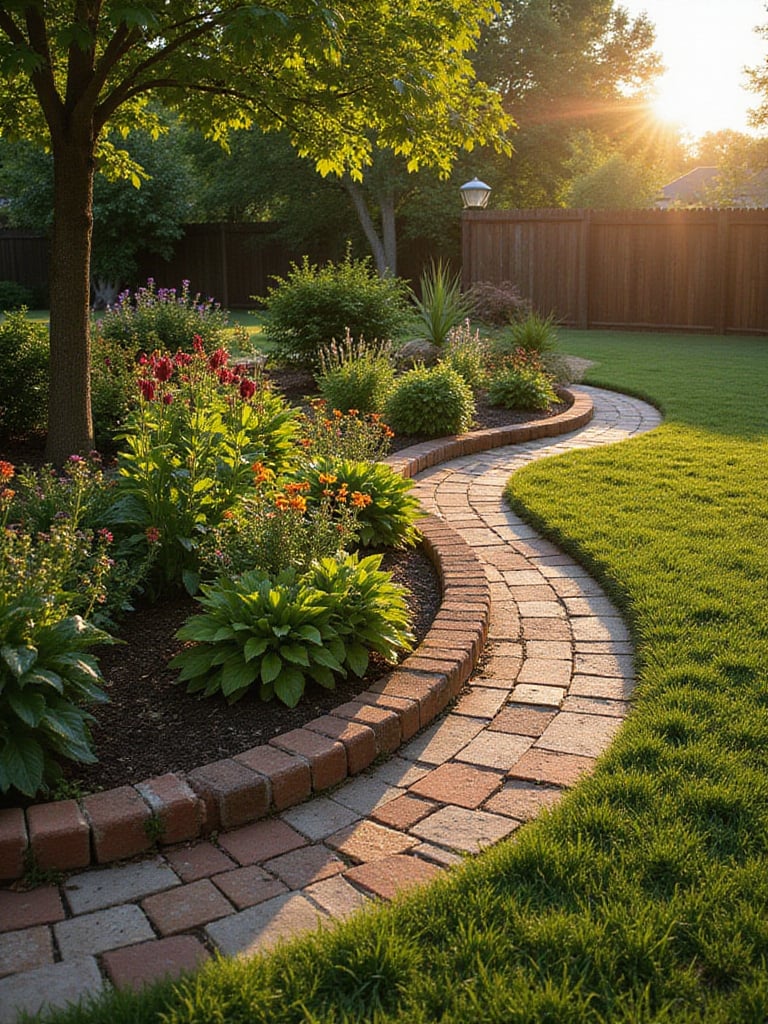
The most effective brick edging styles include:
- Soldiers: Bricks stood upright in a row
- Sailors: Bricks laid flat in a row
- Sawtooth: Bricks set at an angle, creating a zigzag effect
- Basketweave: Alternating horizontal and vertical bricks
- Sunken: Bricks partially buried for a subtle effect
For an authentic look, choose bricks with some patina—those with slight moss growth or faded colours will blend more naturally with your planting. Set them into a shallow trench with sand beneath for levelling, and use a spirit level to ensure they’re properly aligned (unless you’re deliberately going for a charmingly wonky cottage garden aesthetic).
The heritage technique gets a contemporary update through thoughtful placement—try curving your brick edging to create flowing, organic shapes rather than rigid straight lines. This approach pairs beautifully with our next backyard idea on a budget, which similarly celebrates the character of aged materials.
14. Upcycle and Decorate with Old Items
The British have always excelled at eccentricity in garden design—from Victorian follies to repurposed architectural elements. This tradition of creative reuse continues today, with vintage finds adding character to outdoor spaces without costing a fortune. Old stepladders become plant displays, chipped enamelware transforms into charming planters, and weathered shutters create vertical interest against walls.

Look for these easily upcycled items:
- Vintage suitcases as quirky planters
- Old wooden doors as garden tables
- Antique bird cages as plant hangers
- Chipped teacups as succulent containers
- Wrought iron headboards as climbing plant supports
The key to successful upcycling lies in creating a cohesive look rather than a jumble of random objects. Consider a unifying colour scheme, perhaps painting disparate items in complementary heritage shades, or group items from similar eras to create a narrative thread through your garden.
“The British garden has always been a cabinet of curiosities—a place where the unexpected delights rather than disturbs, where whimsy and practicality coexist in perfect harmony.” – Garden designer Penelope Hobhouse
The unexpected pairing that always works is combining these characterful vintage elements with structured planting. This balance of order and surprise leads naturally to our next backyard idea on a budget, which adds vertical structure through simple construction.
15. Build a Quick DIY Trellis
The British garden has long celebrated vertical elements—from the elaborate Victorian plant supports at Kew to the simple hazel structures of cottage gardens. A DIY trellis continues this tradition, adding height and structure while supporting climbing plants that bring colour, scent and wildlife to your garden. Using inexpensive materials like bamboo canes, reclaimed timber or even fallen branches, you can create an effective plant support for under £20.
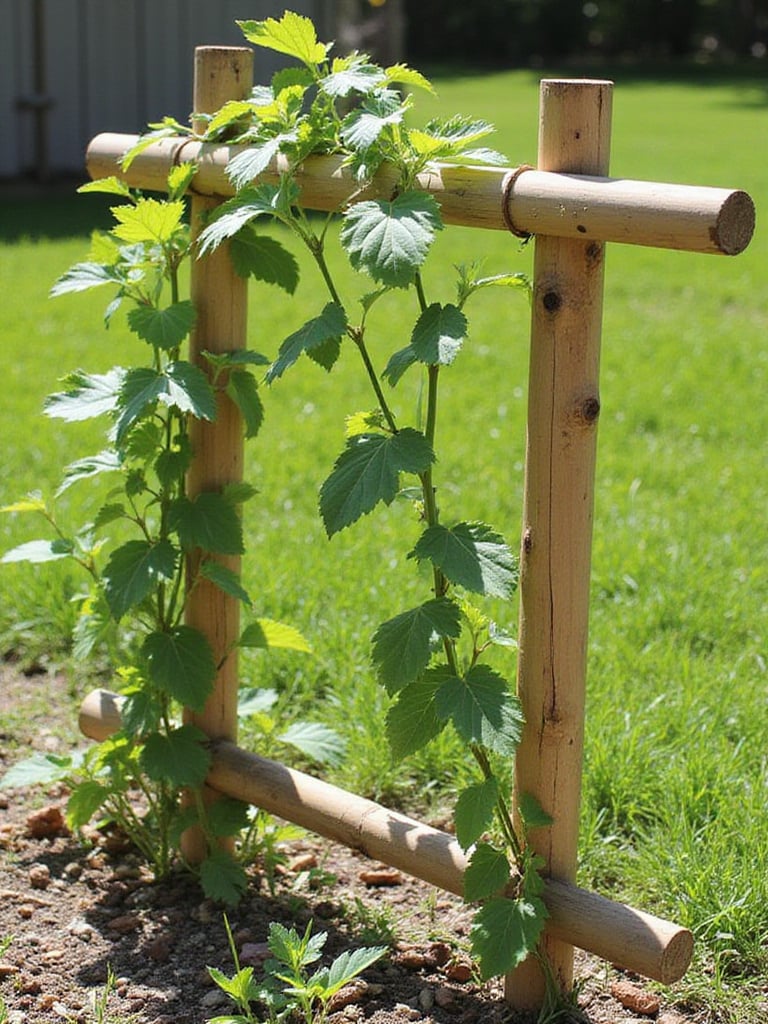
Consider these simple trellis designs:
- Fan-shaped supports for wall training
- Wigwams for sweet peas or runner beans
- Diamond lattice panels between posts
- Willow woven between upright stakes
- Simple post and wire systems for roses or clematis
For a distinctly British approach, look to traditional materials—hazel and willow have been used for centuries and can often be sourced for free if you have access to woodland. Alternatively, bamboo canes lashed together with garden twine create effective structures with minimal expense.
The designer’s secret here is to ensure your trellis complements both the architecture of your home and the plants it will support—delicate climbers like sweet peas need finer supports than vigorous roses or clematis. Once your vertical elements are in place, you’ll want to add colour throughout the seasons, which brings us to our next affordable garden enhancement.
16. Add Pops of Colour with Inexpensive Annuals
British gardens are renowned for their exuberant colour combinations, from the bold borders of Hidcote to the cottage garden jumble of profuse blooms. Annual flowers offer the most economical way to achieve this effect, with a packet of seeds costing as little as £2 yet potentially producing dozens of plants. Even ready-grown bedding plants remain affordable when purchased as multi-packs from garden centres or market stalls.
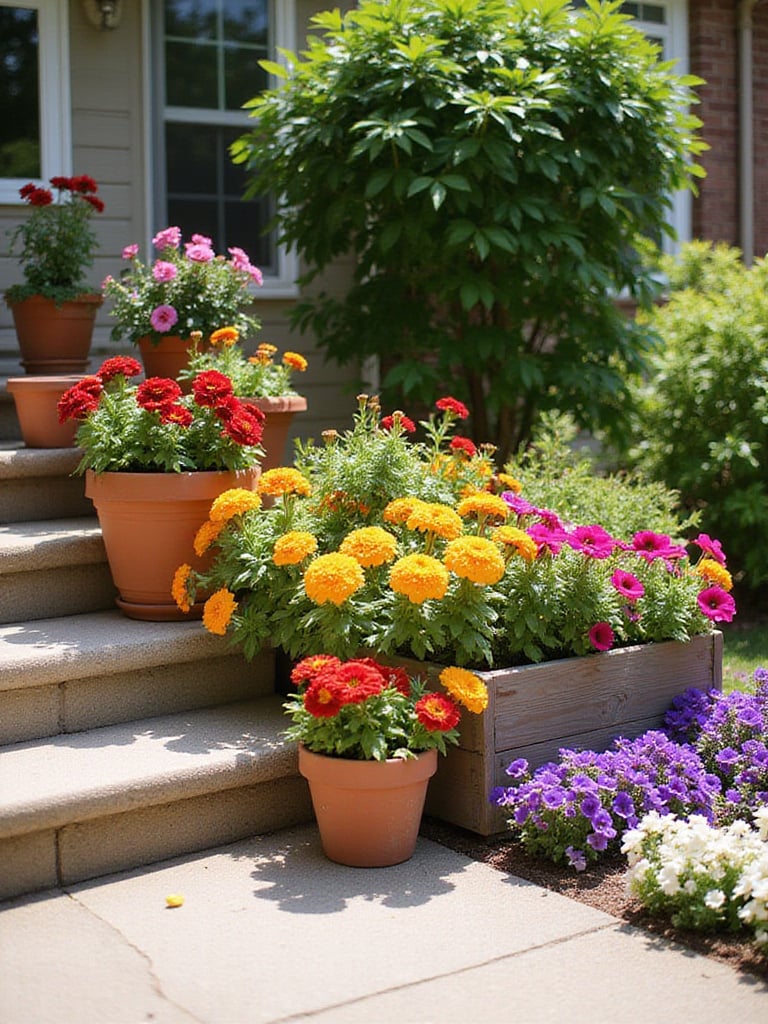
For maximum impact with minimal investment, consider:
- Cosmos: Tall, airy flowers that bloom for months
- Nasturtiums: Edible flowers in vibrant oranges and reds
- Sweet peas: Quintessentially British with incredible fragrance
- Sunflowers: Dramatic height and cheerful blooms
- Nigella (Love-in-a-mist): Self-seeds readily for future displays
The British approach to using annuals often involves what garden designer Gertrude Jekyll called “drifts”—informal groupings of the same plant that create impact through repetition. Rather than dotting single plants throughout a border, cluster them in generous groups for a more cohesive effect.
The unexpected environmental benefit comes from the nectar-rich blooms that support our declining pollinator populations. This wildlife-friendly approach connects beautifully to our next backyard idea on a budget, which creates a restful spot for observing your garden’s natural beauty.
17. Create a Cozy Seating Nook
The British have elevated garden seating to an art form—from the curved stone exedras of stately homes to the humble bench tucked into a fragrant corner. Creating a cosy nook needn’t be expensive; it’s about finding a sheltered spot with an appealing view and making it inviting. A simple bench between existing shrubs, a pair of chairs beneath a tree, or even a blanket spread on level ground can become a destination when thoughtfully positioned.
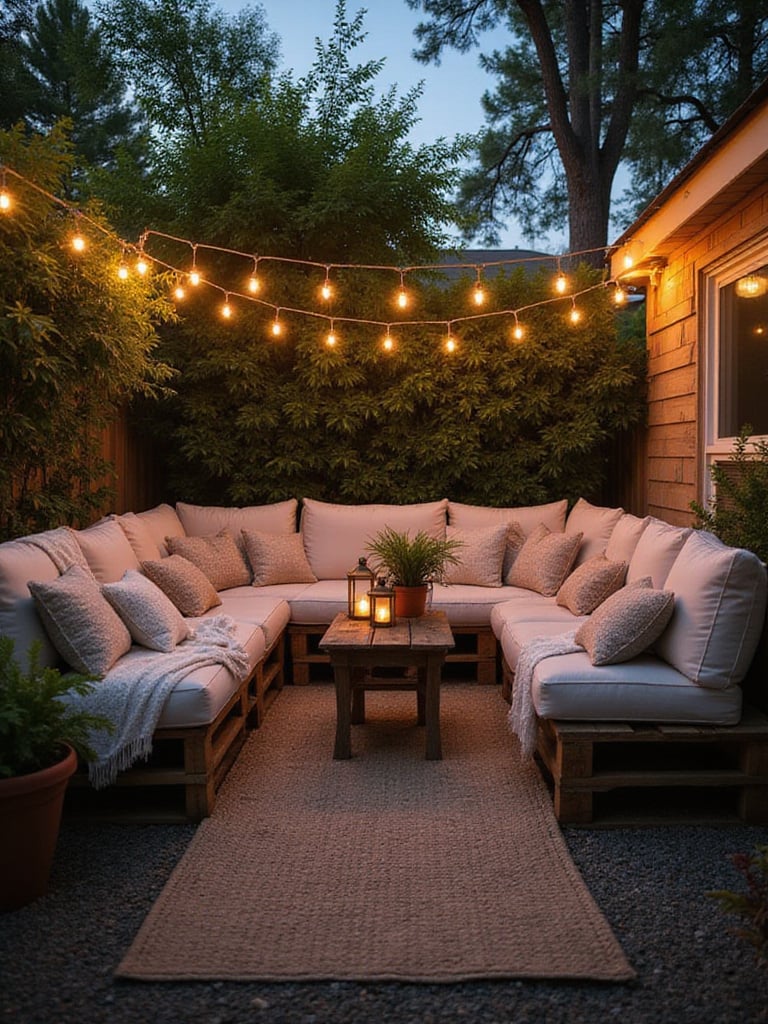
To enhance your seating area without spending a fortune:
- Position to capture morning or evening sun, depending on when you’ll use it most
- Create a sense of enclosure with tall plants or climbers on a simple structure
- Add outdoor cushions in weatherproof fabrics (or bring indoor ones out when needed)
- Consider scent—plant fragrant flowers nearby or herbs you can brush against
- Include a small surface for drinks—even a flat stone or upturned crate will do
The concept of “prospect and refuge” underpins the most successful garden seating—we instinctively prefer spots that feel sheltered (refuge) while offering a view (prospect). Position your seating with its back protected by planting or a structure, facing toward an attractive vista, however modest.
The emotional response this evokes begins with a sense of sanctuary—a private retreat within your own garden where you can pause and observe the fruits of your labour. This contemplative quality connects perfectly to our next backyard idea on a budget, which introduces the soothing element of water.
18. Install a Small, Simple Water Feature
Water has featured in British gardens since medieval times, evolving from practical fishponds to ornamental features that delight the senses. Today’s budget-friendly options allow anyone to incorporate this element without extensive plumbing or expense. A simple container water garden, solar fountain, or bubbling urn can be created for under £100, bringing movement, reflective light, and the gentle sound of water to your outdoor space.

The simplest water features include:
- Ceramic pot fountains with recirculating pumps
- Solar-powered floating fountains for existing containers
- Repurposed stone troughs with small submersible pumps
- Bubbling millstones or rocks
- Mini-ponds in half barrels or ceramic pots
For a distinctly British touch, look to our garden heritage—a weathered stone trough planted with moisture-loving ferns around a gentle bubbler evokes the tranquility of a woodland stream. Position your water feature where it catches light at certain times of day, creating sparkle and movement.
The artisan’s journey from apprentice to master influenced many traditional water feature designs, from simple stone basins to more elaborate fountains. This appreciation for craftsmanship extends naturally to our next backyard idea on a budget, which turns garden waste into garden gold.
19. Build a Basic Compost Bin
Composting has been integral to British gardening since medieval times, when monastery gardens relied on this natural process to enrich their soils. Today, creating your own compost remains one of the most economical and environmentally sound backyard ideas on a budget. A simple bin constructed from reclaimed pallets or wire mesh costs next to nothing yet transforms garden and kitchen waste into nutrient-rich soil conditioner.
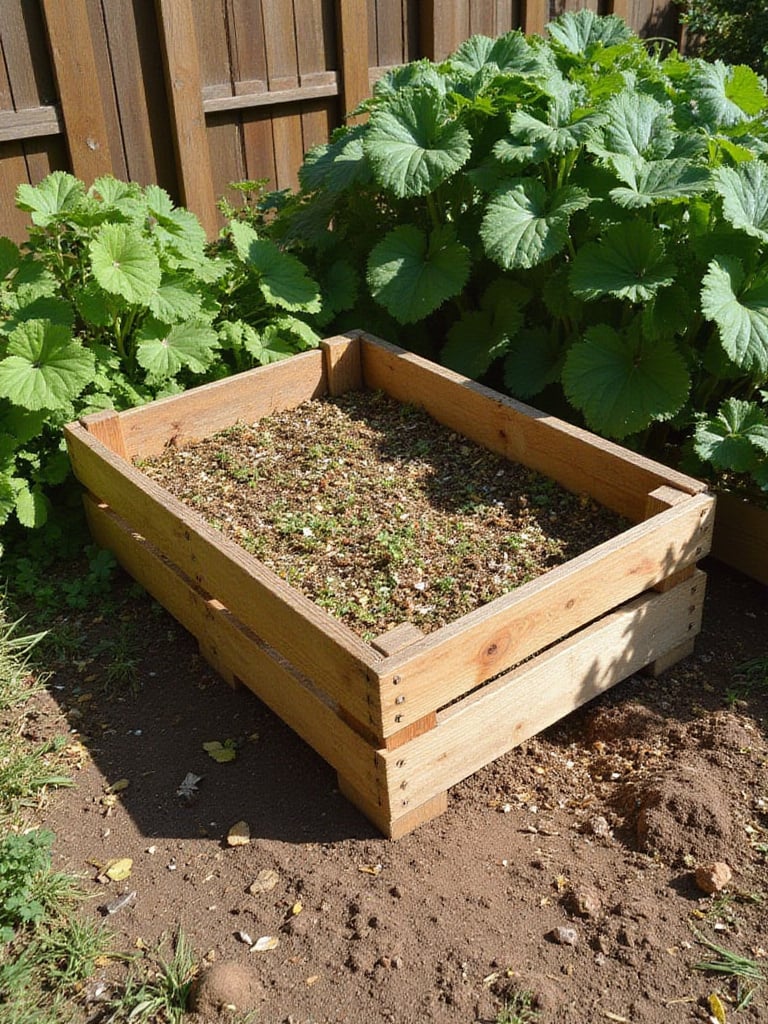
For successful composting:
- Position your bin in partial shade to prevent it drying out
- Aim for a mix of ‘green’ materials (vegetable scraps, grass clippings) and ‘brown’ (cardboard, dry leaves)
- Turn the contents occasionally with a garden fork to aerate
- Keep reasonably moist—like a wrung-out sponge
- Harvest finished compost from the bottom while adding fresh materials to the top
The British approach to composting tends to be pragmatic rather than precious—a simple structure that functions well is preferable to an elaborate system that’s complicated to use. The satisfaction comes from completing the garden cycle, returning plant matter to the soil to nurture next season’s growth.
The sustainable journey of this material involves ancient processes of decomposition harnessed for garden benefit—microorganisms, insects and worms all play their part in breaking down waste into rich humus. This natural cycle connects beautifully to our final backyard idea on a budget, which harnesses another natural resource: sunlight.
20. Illuminate Paths with Solar Lights
Lighting extends the enjoyment of British gardens into our long summer evenings and creates winter magic during the darker months. Solar path lights offer an economical solution, requiring no wiring or ongoing electricity costs. A set of basic solar stake lights starts from around £15, while more decorative options might cost £30-50 for a set—still considerably less than installed electrical lighting.
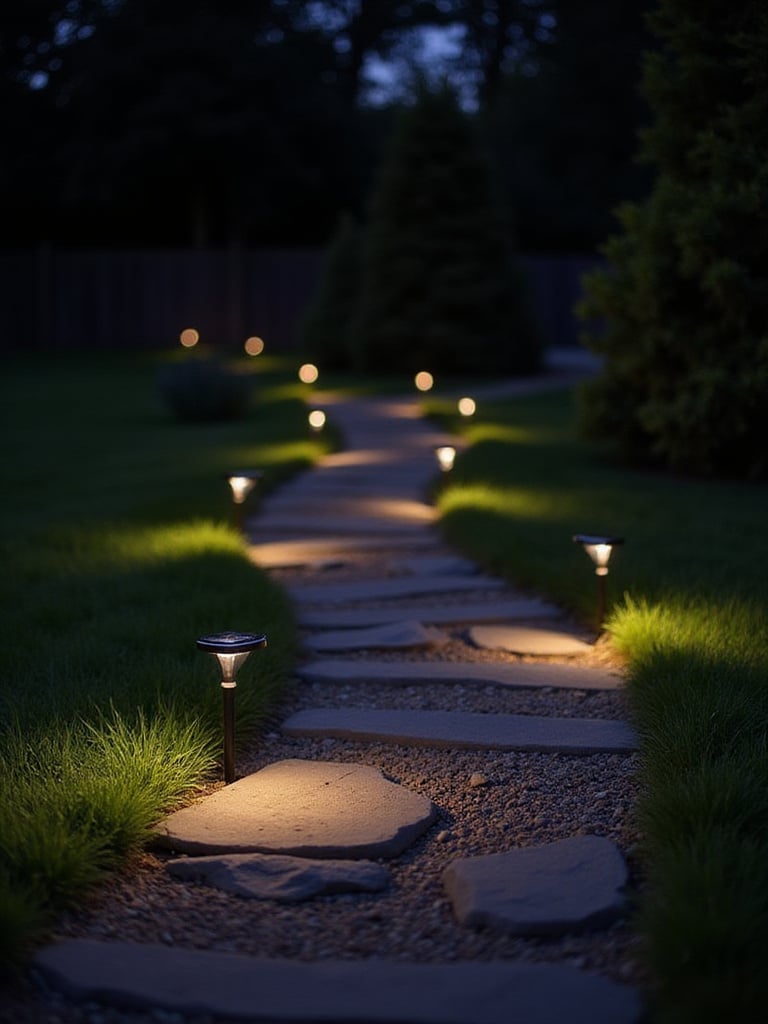
For effective path lighting:
- Space lights at regular intervals (typically 1.5-2m apart)
- Position to highlight changes in level or direction
- Choose brightness appropriate to your needs—subtle is often better
- Select designs that complement your garden style
- Consider height—taller lights cast wider pools of illumination
The British garden lighting tradition tends toward the understated—gentle pools of light that guide rather than flood, creating mystery and shadow rather than flat illumination. This approach not only looks more sophisticated but also consumes less energy and reduces light pollution.
The seasonal adaptation reveals itself as these lights create entirely different effects throughout the year—summer foliage creates dappled shadows and winter’s bare branches cast dramatic patterns. This year-round appeal makes solar lighting one of the most versatile backyard ideas on a budget.
Conclusion
These 20 backyard ideas on a budget demonstrate that creating a beautiful outdoor space needn’t require lavish spending—just a touch of creativity and a willingness to work with what you have. The British garden tradition has always valued ingenuity alongside aesthetics, finding beauty in repurposed objects, seasonal changes, and the gradual development of character over time.
Whether you implement a single idea or combine several, remember that the most memorable gardens evolve gradually. Start with the elements that bring you the most joy—perhaps a cosy seating nook where you can plan the next phase of your garden’s development, or a simple herb garden that connects you to centuries of British growing traditions.
The true magic of these backyard ideas on a budget lies not just in their affordability, but in how they transform your relationship with your outdoor space. A garden created with your own hands, reflecting your personal taste and solving your unique challenges, will always bring more satisfaction than one simply purchased and installed. As we say in British garden design circles: the best gardens are never finished—they’re merely begun.
